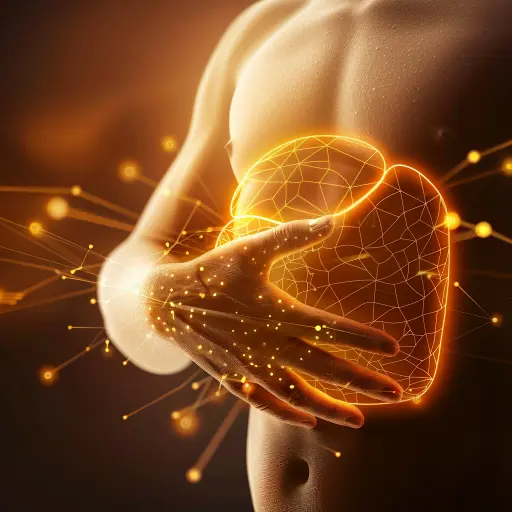Rash Skin- The Link Between Liver Malfunction and Skin Health
Liver health is closely linked to skin health and appearance. A compromised liver can lead to a buildup of toxins in the body, resulting in various skin issues. Changes in the skin color (yellowing, bronze skin, etc.) are associated with serios deceases, but even the overall unhealthy look of the skin is often a symptom for liver disorders. Poor liver function can cause the skin to develop rashes, pimples, and a generally unhealthy appearance due to the liver’s reduced ability to detoxify and regulate metabolism effectively. Thus, maintaining liver health is crucial for preserving clear, vibrant skin. When the liver is not functioning properly, toxins can accumulate in the body, leading to various skin issues:
Pimples and Acne– Toxins can cause inflammation and clogged pores, leading to acne.
Rashes– Accumulation of toxins and metabolic by-products can cause skin irritation and rashes.
Dull and Unhealthy Skin– Poor liver function can result in nutrient deficiencies, leading to a lackluster and unhealthy skin appearance.
Nutritional deficiencies in choline, inositol, methionine, and taurine can severely affect liver function and, consequently, skin health. These deficiencies can lead to impaired liver detoxification and metabolic processes:
Choline:
- Function: Essential for lipid metabolism and detoxification processes in the liver.
- Impact on Skin: A deficiency can lead to fat accumulation in the liver, impairing its ability to detoxify and leading to skin problems, manifesting as acne-prone skin due to increased toxin levels in the blood.
Inositol:
- Function: Important for cell membrane integrity and lipid metabolism.
- Impact on Skin: Deficiency can disrupt cell signaling and fat metabolism, resulting in poor skin health, increased inflammation, causing rashes and pimples.
Methionine:
- Function: Crucial for methylation reactions and the synthesis of SAMe, which is vital for liver repair.
- Impact on Skin: Deficiency can impair detoxification processes and lead to buildup of toxins, causing skin irritation and unhealthy appearance.
Taurine:
- Function: Supports bile salt formation, detoxification, and antioxidant protection.
- Impact on Skin: A deficiency can reduce bile production and antioxidant capacity. Increases oxidative stress and inflammation, may result in rash and damaged skin.
Health Implications of Poor Skin and Liver Health
The connection between liver health and skin condition highlights the broader implications for overall health:
- Systemic Inflammation: Chronic skin issues can be a sign of systemic inflammation and oxidative stress.
- Metabolic Disorders: Poor liver function is often associated with metabolic disorders such as insulin resistance and obesity.
- Nutritional Imbalance: Skin problems can indicate underlying nutritional deficiencies that affect overall health.
Prevention and Management
To maintain both liver and skin health, it is essential to address nutritional deficiencies and support liver function:
- Balanced Diet: Ensure adequate intake of choline, inositol, methionine, and taurine through a balanced diet.
- Hydration: Stay hydrated to support liver detoxification and skin hydration.
- Regular Exercise: Promote liver health and improve overall metabolism.
- Limit Alcohol and Toxins: Reduce exposure to substances that can impair liver function.
Conclusion
Healthy skin is often a reflection of a healthy liver. Nutritional deficiencies can significantly impact liver function and, consequently, skin health. LiverGuard delivers Choline, Inositol, Methionine, and Taurine in HIGH DOSE, supporting a fast and safe liver regeneration process, which will help you promote your skin look and overall health.
References
- Zeisel, S. H., & da Costa, K. A. (2009). Choline: An Essential Nutrient for Public Health. Nutrition Reviews, 67(11), 615-623.
- Buchman, A. L., Sohel, M., Brown, M., Jenden, D. J., & Roch, M. (2001). The Effect of Choline Supplementation on Hepatic Steatosis in Patients Receiving Home Parenteral Nutrition. Hepatology, 34(3), 333-340.
- Beale, A., & Garcia-Perez, A. (2020). The Role of Inositol in the Treatment of Insulin Resistance. Clinical Therapeutics, 42(1), 63-72.
- Croze, M. L., & Soulage, C. O. (2013). Potential Role and Therapeutic Interests of Myo-Inositol in Metabolic Diseases. Biochimie, 95(10), 1811-1827.
- Finkelstein, J. D. (1990). Methionine Metabolism in Mammals. The Journal of Nutrition, 120(8), 1474-1477.
- Zeisel, S. H. (2006). Choline: Critical Role During Fetal Development and Dietary Requirements in Adults. Annual Review of Nutrition, 26, 229-250.
- Hayes, K. C., & Sturman, J. A. (1981). Taurine in Metabolism. Annual Review of Nutrition, 1, 401-425.
- Marcinkiewicz, J., & Kontny, E. (2014). Taurine and Inflammatory Diseases. Amino Acids, 46, 7-20.
- Targher, G., Corey, K. E., Byrne, C. D., & Roden, M. (2021). The Complex Link between NAFLD and Type 2 Diabetes Mellitus — Mechanisms and Treatments. Nature Reviews Gastroenterology & Hepatology, 18(9), 599-612.
- Kawanaka, M., Nishino, K., Nakamura, J., Urata, N., & Oka, T. (2021). Nutrient Deficiencies in Patients with Non-Alcoholic Fatty Liver Disease. Clinical Nutrition ESPEN, 41, 249-256.
- World Health Organization. (2020). WHO Guidelines on Physical Activity and Sedentary Behaviour.
- Day, C. P. (2006). From Fat to Inflammation. Gastroenterology, 130(1), 207-210.














